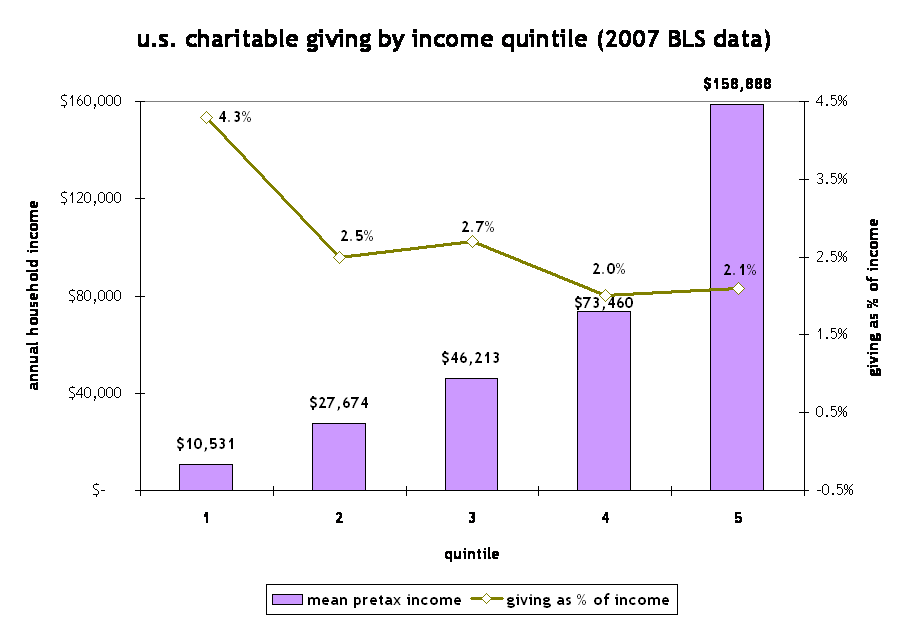The graph below reveals the percent of before-tax income given to charity by class (separated into fifths):

There is a positive correlation between income and absolute giving (the higher their income, the more money they donate), but a negative correlation between income and relative giving (as incomes go down, households donate a higher and higher percentage of their income).
From Chris Uggen’s weblog via.
—————————
Lisa Wade is a professor of sociology at Occidental College. You can follow her on Twitter and Facebook.

Comments 12
thoughtcounts Z — June 5, 2009
I'd love to see what types of charities households in different divisions (quintiles, whatever) tend to donate to. In particular, I wonder how charitable giving to one's religion differs -- if practices like tithing being more or less common explain some of this difference. But other interesting trends might pop out, too.
Shinobi — June 5, 2009
I think it might also be interesting to look at this trend over time, as well as the dataset as a whole. I think it would be interesting to segment by donation % of total income, and see what the average income came out to be, I wonder if there are variations within the quintiles that could allow us to draw some insights into donation patterns as well.
George — June 5, 2009
Let's not think the upper income people are too stingy. There is a positive correlation between income and both relative and absolute taxation. Taxation is a bit like charity, except you get thrown in jail if you don't pay it.
I'm too poor to worry about it, but I think if I gave 40% of my income to the government (which will mostly be used for various social programs ) I might not be particularly inclined to give that much additional money to charity.
Hank — June 5, 2009
George, I think if you were giving 40% of your income to the government, you would be making enough money that giving a little to charity really wouldn't hurt that much. Unless, of course, you just really need that new boat.
AR — June 5, 2009
Why is before-tax income used, instead of after-tax, which is to say, actual, income?
Frank — June 5, 2009
To me this graph shows a minimum bound on giving.
That is, even lower classes buy a few candy bars for the schools or a box of girl scout cookies or throw money into the church collection box.
There's still a negative correlation, certainly, but not as pronounced as implied by the lowest quintile's data point.
Also, as someone else implied, with all the social programs tax revenues fund, I would imagine many in the highest quintile consider a good portion of my highest quintile taxes to be effective donations.
Frank — June 5, 2009
More about the tax thing:
In fact, looking at the graphed data there seem to be two step downs, the 4th and 5th quintile give at ~2%, while the 2nd and 3rd quintiles give at around 2.5%, and the lowest quintile gives at a higher rate (again, I acknowledge that this is crude data, and thus to find any real results beyond what's given)
I note that the first two (and the two largest) bumps in marginal tax rates (10-15% and 15-25% of income) happens at $16,700 and $67,900 of income, exactly where those two "steps" occur.
Clearly not definitive of anything, but interesting to consider.
Dubi — June 5, 2009
I'm with AR (and Frank) - I think this graph is deceptive, and the trend will we eliminated if we look at actual income, after tax.
Former George — June 5, 2009
I'd like to point out, that the George who commented above is not me. I have a new name now, ever since George Harrison besmirched mine on the orange juice post, so there. I am the George who changed their name from Jenna in the comments. I notice that Original Will has the same impersonation/to common a name problem, too.
Signed,
Formerly "George"
Jamie — June 6, 2009
interpreting a correlation from this data may not be fruitful. A confidence band around these estimates might show little differences among groups.
From my perspective, an interesting conclusion is that giving takes place across all levels. Additionally, we seem to have a baseline level of giving around 2%.
Er sosialdemokratiet mer moralsk enn liberalismen? - Radkap — December 19, 2015
[…] er det slik at jo rikere man er, jo mer gir man (i snitt) til veldedige formål. 2) Det betyr at desto rikere et samfunn er, desto mer vil det gis til gode formål, og det vil […]
Lynne Kelley — January 6, 2025
Absolute charitable giving refers to the total amount a person or organization contributes to charity, regardless of their income or wealth. It’s a fixed amount that doesn't consider the giver’s financial situation. On the other hand, relative charitable giving takes into account the donor’s income or wealth, encouraging individuals to give a percentage that aligns with their financial capacity. The latter approach is seen as more equitable, as it asks for contributions that are more proportional to a person’s means, potentially fostering a greater sense of responsibility among wealthier individuals.
For those exploring options for financial assistance, it's worth looking into resources that offer tools like an str login check for financial help" to assess eligibility for potential support.